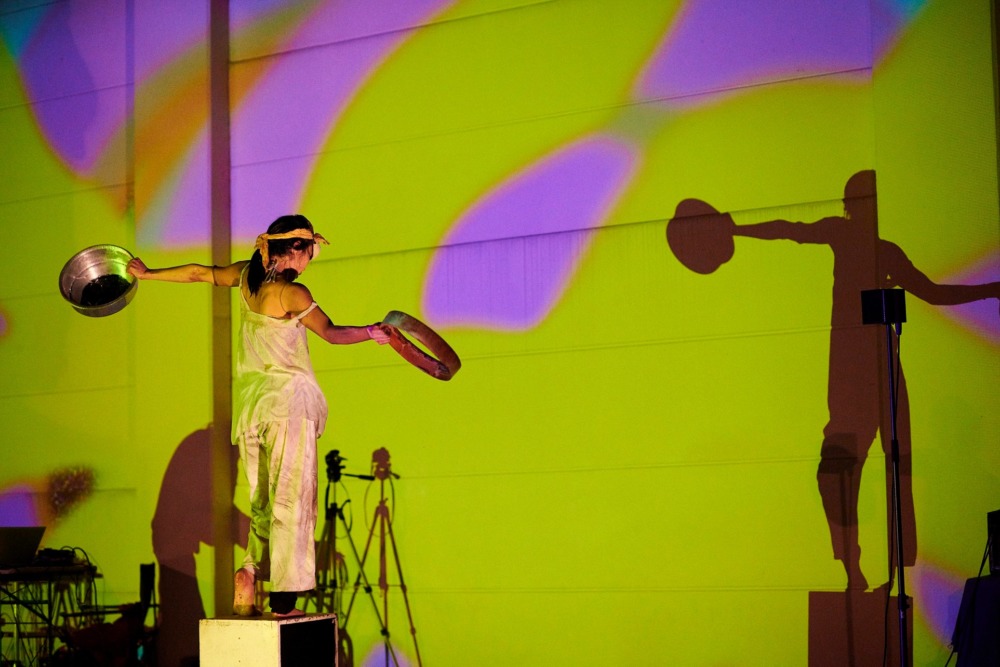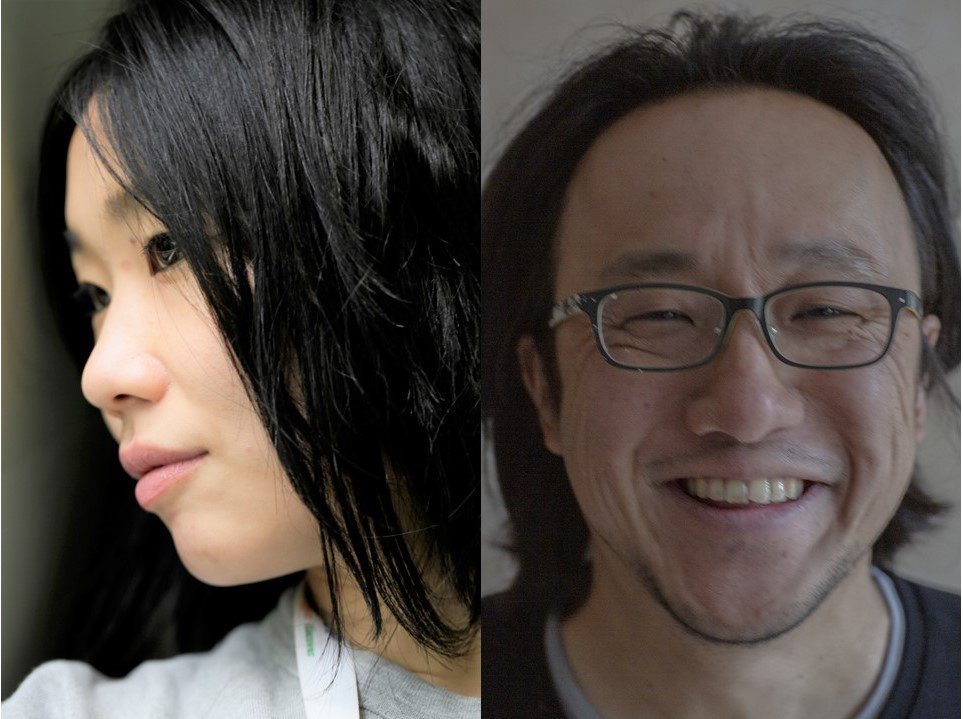- Date: 30 May 2020
- Content:
The Berlin-based artist group Elektro Kagura (Ichi Go, Yukihiro Ikutani, AXL OTL; photo by Jide Tom Akinleminu) performed in Dusseldorf with Dusseldorf-based artist Taka Kagitomi. He organized the project Autoconcerto (a concert that the audience sees in their cars). He performed “ikutaniSAN”, a 2017 production based on the story of KOJIKI. - Promotion Tool: Facebook, Email, HP
- Distribution Tool: YouTube
- Twists to get attention and reactions from audiences:
Use of hashtags: #ArtAction #LiveSession #LiveStreaming #Berlin #LivePainting #ContemporayDance #コロナに負けるな #コンテンポラリーダンス #ライブペインティング - The number of views:
75(as of 11 June 2020)
Column
Column[#KeepgoingTOGETHER] Vol. 49 ① / ELEKTRO KAGURA at Autoconcerto
Impressions Gained through Online Activities
First of all, from my first impression of the venue, I felt that it was an open space for us to use, as it is a privately owned factory site, and above all Because of the similarity of the environment to the studio where I was working, I felt a sense of familiarity and various ideas came to me. However, at the same time, it is different from the hermetically sealed space of a theater, and under the corona regulation, it was not possible to view the work in a car. but there were not as many visitors as expected (probably less than 30).
Based on the way most of them were watching from outside the car, I immediately changed the way of expression. The original was mainly about music and visuals, and I had anticipated that I would occasionally be able to see dancing from a live camera at close range on the large wall of the stage backdrop. In addition, I decided to make the most of the difference in elevation, wearing kimonos and driving cars to free myself from the gentle slope of the ground and the academic atmosphere of the Rhine River area.
Ikutani, on the other hand, took more time to set up the live camera than he had expected, and he wasn’t able to prepare himself. AXLOTL is unavoidable in terms of technique, with the PC crashing just before the show. Trouble ensues.
As a countermeasure, it is important to anticipate technical problems and practice on a regular basis. It takes a lot of practice just to get the music and images to match perfectly. And that alone is spectacular enough. The work has been presented for about four years now, and we have boldly reformed the structure of the piece and created a piece without dancing or Dance only (this is a personal touring experience), to keep performing the same piece under different conditions. To keep the most important things in mind and to keep the work flexible and fresh.
-Arrive at the venue well in advance.
Even if you arrive three hours before the performance, especially if you do not have a rehearsal with a new organizer, face-to-face meetings and technical rehearsals are necessary and time-consuming.
The need for regular practice, self-learning, and image training with the performance in mind. I was aware of the Kagura, and by teaching (demonstrating) online by myself, I was able to get nervous. Continue to consciously bring the extraordinary into the everyday to keep the senses intact and not dull the intuition. I’ve been working with the traditional Indonesian performing arts and local performing arts, in direct contradistinction to what Kagura is all about. It has been. The intangible culture, life, and ancient mythology of local production and consumption. Dance has the advantage of expressing the argument physically.
(Ichi Go)

©Jassin Eghbal
Changes and Twists Taken at This Time Compared to Previous Online Activities
The live streaming I used to do was very simple, one-on-one sessions with other dancers, musicians, or collaborations with Ikutani’s paintings. The last time I broadcasted a performance live as I did this time was about two years ago when I was involved in the “Ikutani X” project, which was a collaboration with Ikutani’s In the finissage of the exhibition, paint, raw eggs, and flour are thrown on the mural and the colors are hung. It was the first time since the action was broadcast live. It was a closed room, and the audience had to wear clothes that they didn’t mind getting dirty or rain gear to protect them, and the cameras were suitably waterproof. The live show has never been as popular as it is today. Live shows have never been as popular as they are today, but Director Frank Castorf, who made a name for himself in Berlin’s theaters, often uses live cameras to show images in his plays.
As for me, I had to stay at home from March this year on a business trip to Indonesia, where I personally developed my interest in live broadcasts and learned how to do so with my body and fingers. I knew that any new technology is hesitant at first, but it can quickly become generalized, mediocre, or, to put it bluntly, boring, so I thought I’d just get started, learn as I went along, and stop when many others started.
But in all things, as an artist and self-employed, there are no excuses under any circumstances. We should not blame anyone else but should use our own abilities to create new values and jobs. This is both a duty and a mission. It is “work”.
That is to say, imitation of others is good for gain and development, but we dare not to fall below it. What’s the point of doing this? This is a question that we should always be aware of and address. As a filmmaker (especially for documentaries) and a cameraman with a lot of international experience, I’m going to make a special trip to Japan. I asked my trusty friend Jide Tom Akinlemiru to take the Videos. He has an outstanding sense of taste and balance. He is ambitious, curious, and friendly. His generous and open-minded viewpoints are the perfect way to get up close and personal with his audience. This is the perspective that I want the audience to have. Also, the feelings of the performer in front of the camera are often stimulated and changed by the photographer. In his case, he does not interfere with the performers, but on the contrary, he does not miss the part that they want to show with his hateful filming. Let me tell you what I did. This confidence is absolutely essential in close up live shooting. Otherwise, the camera would be fixed or controlled by itself. Furthermore, I asked him to shoot for my “Requiem Sachiko” project as well. From his two experiences, he came up with the idea of having the audience film the film. Such ingenuity is inexhaustible in my profession.
In addition, my daily work of creating archives is strictly a documentary, and I wanted to make sure that the quality of the footage was better than the realism of a live performance. We tend to focus on picture and sound quality and try to look as cool as possible, but the Dusseldorf in the community of art college graduates and local artists in The call (what we want to tell you) to do how freely you can do the same thing was directly conveyed to us, the Berlin The members of the group were impressed with an inexplicable sense of nostalgia and comfort.
As an archive, it is important to edit and preserve it while the heat is hot and the memory is fresh, but there is no right or wrong in art, just as there is no right or wrong in life. But it means that somewhere we have to make up for it, that we have been called to be a guest and If it is done, it is based on the response of the organizers and the audience. We’ve received a certain amount of feedback and would like to co-host with them as well or invite them to come here to run their own projects. I think.
(Ichi Go)

©Jassin Eghbal
Suggestions and Opinions towards Online Activities
In this world situation, the importance of networks has accelerated more than ever before. Artists are also members of society, and we must ask ourselves what we can do as artists to respond to this situation. We agree with your question, and despite our inexperience, we will do our best to answer it. Thank you very much. I am very grateful for this opportunity.
I would like to make the most of the advantages of living abroad and continue to collaborate actively with people who are active in foreign countries It is. No matter how advanced the network may be, places to live and communities are still very important for the foundation of our lives and work. So, while always keeping this in mind, we are always looking at the development of technology in a positive light and making full use of the network to make the most of it. I am determined to be actively involved with people around the world. It is this difficult situation that we, as artists, need to be proactive in finding answers and making proposals. We are committed to promoting the social role of artists in society.
I am aware that in Japan, public support for small and medium-sized art activities is less than in Europe. The artists who work on this scale will be the ones who will have a strong social influence in the future. I think there is a lot of potential. We have a lot of very talented artist spawn in Japan, and the existence of a socially conscious organization like yours is a good thing. PechaKucha is an integral part of the development of the Japanese art world. I felt this during the presentation. We sincerely hope that you will continue to offer us such opportunities in the future. We believe that the speed and flexibility of the process by which you decided to support us are difficult to achieve in a European institution. I hope that you will continue to do so. I hope you will continue in this regard as well. Thank you very much.
(Ikutani)
<Program>
ELEKTRO KAGURA at Autoconcerto








